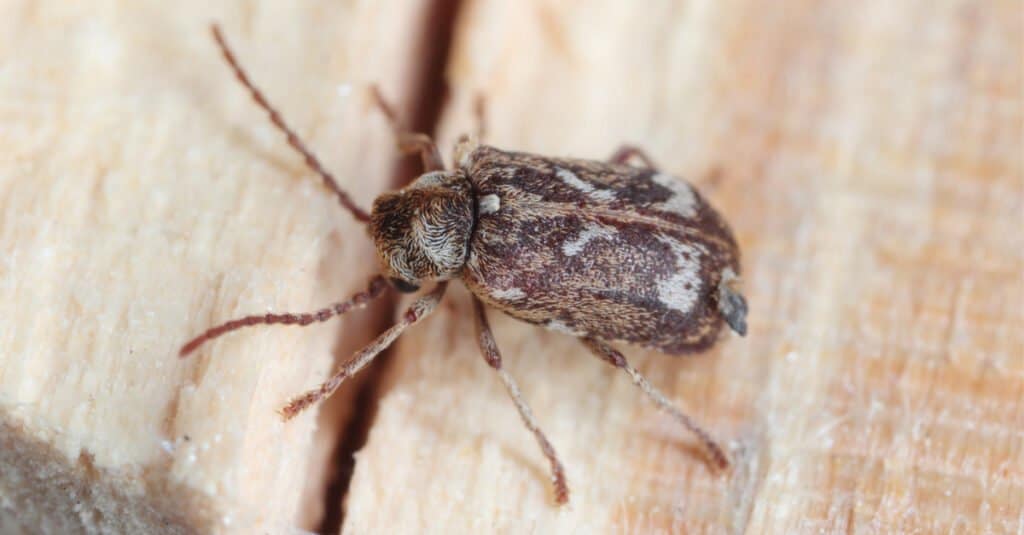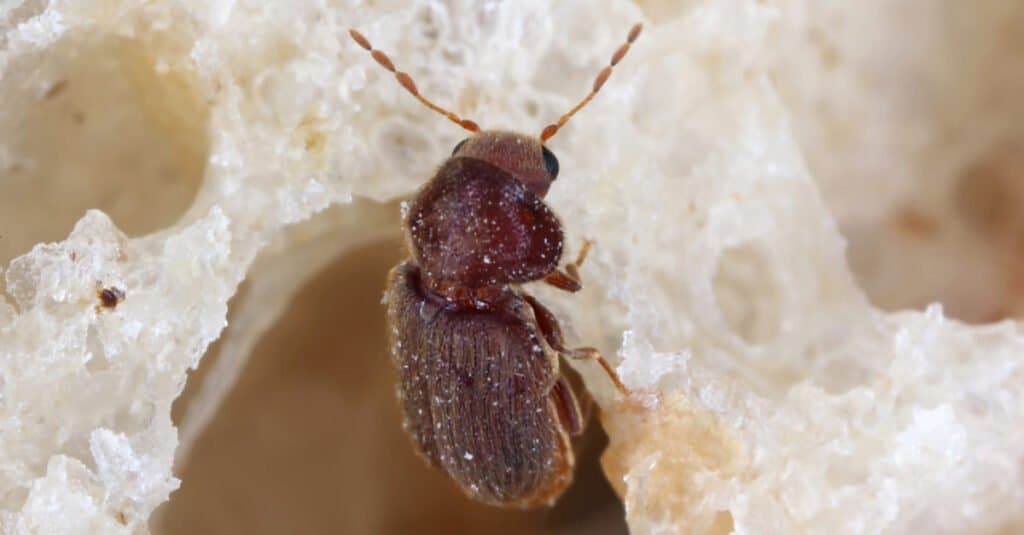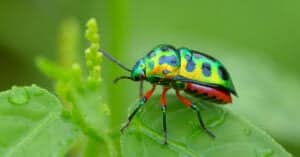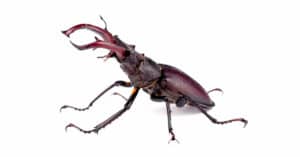Beetles are some of the most diverse animals in the world. There are more than 400,000 recognized species, most of which live out in the wild, never even bothering humans. Some of them fly through the air and light up the night sky, while other beetles create large balls of dung for the larvae to feed on. However, some annoying species are specialized to infect human homes and buildings. Once they’re in the home, these select species of house beetles destroy property or eat human food. They can be very difficult to remove without a lot of time and effort.
This article will cover some important facts about the different types of house beetles, including their identification and prevention. In order to appear on this list, beetles must do most of their damage in the home and not necessarily the surrounding garden or yard.
How to Identify House Beetles
Perhaps the easiest way to identify different types of common house beetles is by their diet and behavior. Each one is very distinct in the way that it infests the home. For instance, wood-boring insects will burrow directly into wood (including furniture, floorboards, and walls) in order to feed and grow. Carpet beetles can be found infesting carpets and other areas of the home with wool, silk, fur, or leather. Some types of grain or dried goods beetles also infest pantries, kitchens, and other food storage areas. You can sometimes see the effects of the infestation before you see the beetles themselves (for example, wood-boring beetles sometimes leave behind a sawdust-like substance).
Appearance is another important part of identification. The shape, color, and size of the house beetle may help you distinguish them from each other. However, this method isn’t always completely reliable, because many species (particularly in their larval stage) look similar to each other. You may have to trap or lure some of the adults first in order to properly identify them. Pest control experts can also help with identification if you plan to use chemical treatments, which might be specialized for only specific kinds of house beetles.

©Tomasz Klejdysz/Shutterstock.com
The Most Common House Beetles
In order to properly identify the most common house beetles, you will need to learn a few basic facts about their appearance and behavior. Here’s a more complete list of what you should look out for if you suspect that you have beetles in house:
- Carpet Beetle: These carpet-eating beetles include several different species, including the common carpet beetle, the brown carpet beetle, and a kind of black beetle as well. After the adults mate, clusters of 50 to 100 eggs are often laid directly on the carpet or fabric so the larvae will begin consuming the fabrics immediately upon hatching. The adults are characterized by oval-shaped bodies with unique mottled patterns of white, brown, yellow, and orange colors. The larvae, which do most of the feeding, are slow-moving worm-like grubs with hairs or bristles covering their tan-colored bodies. They create holes in the fabric and leave behind molted skin as they graze.
- Biscuit Beetle: These common house beetles, which measures no more than four millimeters in size, have a long reddish brown pill-shaped body with noticeable grooves or pits running along the length of the wing cases. The larvae are small white grubs with short hairs and brown mouths. When they infest the home, biscuit beetles (also known as bread beetles and drugstore beetles) feed on dried plant products such as bread, rice, seeds, pasts, beans, cereals, seeds, spices, tea, and tobacco. They can be found inhabiting warm, undisturbed, dark areas in warehouses, homes, restaurants, and stores around the world.
- Common Furniture Beetle: The common furniture beetle, which measures about four millimeters in size, looks a lot like the biscuit beetle, except it has a “monk’s cowl” covering the head. The main difference is that furniture beetles, true to their name, infest wood instead of food. After mating, the females lay their eggs directly in the cracks or holes of the wood. When the white C-shaped larvae hatch, they burrow straight through the wood to feed. This life stage can last three to four years before they become an adult. Despite the name, they also infest floorboards and walls as well.
- Powderpost Beetle: The powerdpost beetle is a group of several species that feast on dry, seasoned wood. The adults come in a variety of different shapes, sizes, and colors, but most tend to be reddish brown or black beetles with elongated bodies. Like the furniture beetle, the growing C-shaped larvae of the powderpost do immense damage by burrowing tunnels beneath the surface to feed. Small round holes in the wood surrounded by powder or dust is a sign of an infestation (though they’re easy to confuse for other wood-boring beetles).
- American Spider Beetle: Measuring just a few millimeters in size, the adult spider beetle is accidentally mistaken for a spider or mite because of its round abdomen and long legs. This black beetle has a glossy abdomen and red or orange-colored legs and head. It is attracted to moist areas with plenty of grains, flour, and other dried food goods. Animal waste, feathers, and nests also attract them. Similar species include the Australian spider beetle, brown spider beetle, golden spider beetle, and white-marked spider beetle.
- Deathwatch Beetle: Another wood-boring insect, the adult deathwatch can be identified by the tapping or clicking sound it makes at night to attract a mate. This tapping sound led to the superstitions which gave it the name. It is characterized by a cylindrical shell with mottled brown colors almost shading into gold. When disturbed, they can play dead by pulling in their legs. Both adults and larvae do damage to moist wood softened up by fungi.

©Tomasz Klejdysz/Shutterstock.com
What Can Be Mistaken for Carpet Beetles?
Carpet beetles are usually mistaken for bed bugs due to their similar size and habitat, yet the primary distinction between the two lies in their dietary preferences. While you certainly don’t want either of these creepy crawlers in your residence, distinguishing between them is crucial for effective prevention and removal.
Another typical indicator of a carpet beetle infestation includes discovering tiny holes in your clothing, carpets, and upholstered furniture.
Since carpet beetle larvae feed in groups, if you notice numerous small holes, it signifies a carpet beetle issue rather than a bed bug infestation.
How to Prevent House Beetles
In order to get rid of beetles from your home, the most important step is to always maintain proper sanitation and hygiene. You should try to clean up spills and messes and never leave out food. Instead, you should keep the food safe in plastic containers (some beetles can bore through aluminum and cardboard). Another important step is to inspect the wood in your home and deal with any old or damp timber to which some wood-boring species are attracted. You should also clean affected areas and items in your home thoroughly; regularly vacuum clean carpets and floors and remove any clutter.
Common house beetles are attracted to sources of light, so try to keep it to a minimum at night to prevent beetles in house. Finally, in order to prevent them from entering, you should seal any holes in the sides of your house and make sure there are screens placed on the windows and doors.
These preventative measures are always the best way to stop an infestation because once beetles actually enter your home, it can be very difficult to eradicate them. Disinfecting items or treating the source of the infestation will usually work well to get rid of the beetles. Chemicals and pesticides should be used as a last resort and applied with care. Read the facts on the label and follow the directions to make sure you are using the product properly. Otherwise, you may accidentally contaminate your home or put your health at risk. It may be necessary to hire a professional exterminator in some cases to eradicate the most difficult and widespread infestations.
Our research shows that some of the most common types of beetles in one’s home are as follows:
- Carpet beetle
- Biscuit beetle
- Common furniture beetle
- Powderpost beetle
- American spider beetle
- Deathwatch beetle
The photo featured at the top of this post is © Henrik Larsson/Shutterstock.com
Thank you for reading! Have some feedback for us? Contact the AZ Animals editorial team.







